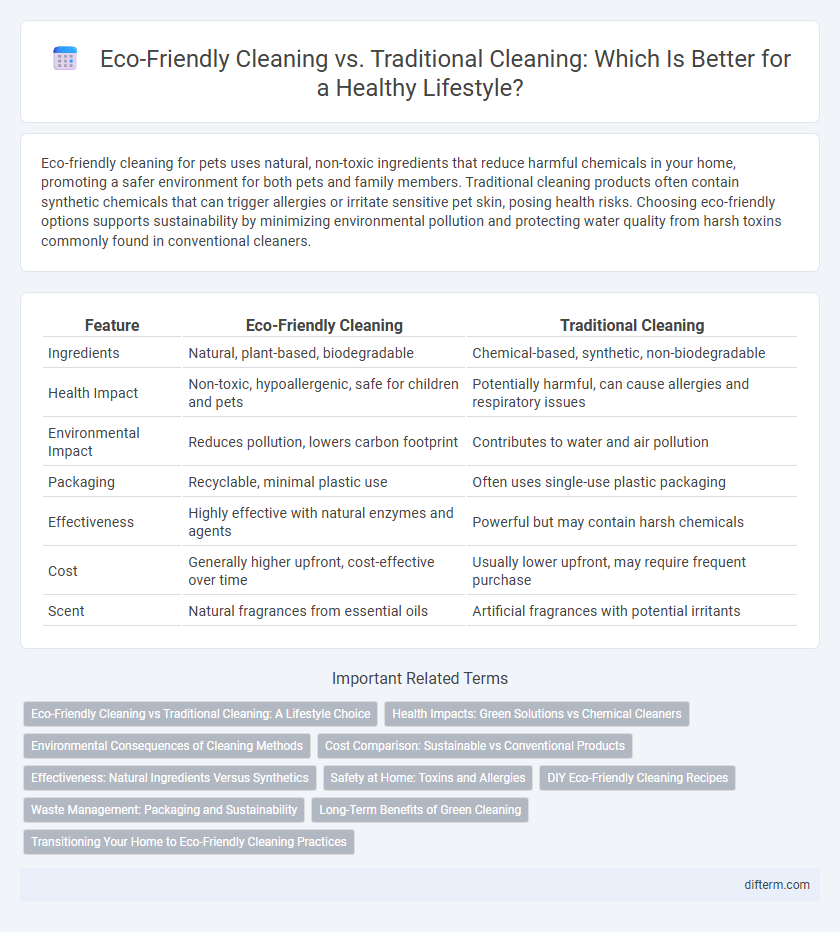Eco-friendly cleaning for pets uses natural, non-toxic ingredients that reduce harmful chemicals in your home, promoting a safer environment for both pets and family members. Traditional cleaning products often contain synthetic chemicals that can trigger allergies or irritate sensitive pet skin, posing health risks. Choosing eco-friendly options supports sustainability by minimizing environmental pollution and protecting water quality from harsh toxins commonly found in conventional cleaners.
Table of Comparison
| Feature | Eco-Friendly Cleaning | Traditional Cleaning |
|---|---|---|
| Ingredients | Natural, plant-based, biodegradable | Chemical-based, synthetic, non-biodegradable |
| Health Impact | Non-toxic, hypoallergenic, safe for children and pets | Potentially harmful, can cause allergies and respiratory issues |
| Environmental Impact | Reduces pollution, lowers carbon footprint | Contributes to water and air pollution |
| Packaging | Recyclable, minimal plastic use | Often uses single-use plastic packaging |
| Effectiveness | Highly effective with natural enzymes and agents | Powerful but may contain harsh chemicals |
| Cost | Generally higher upfront, cost-effective over time | Usually lower upfront, may require frequent purchase |
| Scent | Natural fragrances from essential oils | Artificial fragrances with potential irritants |
Eco-Friendly Cleaning vs Traditional Cleaning: A Lifestyle Choice
Eco-friendly cleaning employs biodegradable, non-toxic ingredients that reduce indoor air pollution and environmental impact compared to traditional cleaning products containing harsh chemicals like ammonia and chlorine. This sustainable approach minimizes water contamination and supports healthier living environments, aligning with growing lifestyle trends favoring wellness and environmental responsibility. Choosing eco-friendly cleaning integrates conscious consumption into daily routines, promoting long-term benefits for both personal health and the planet.
Health Impacts: Green Solutions vs Chemical Cleaners
Eco-friendly cleaning products reduce exposure to harmful chemicals like ammonia and bleach, decreasing respiratory issues and skin irritation often associated with traditional cleaners. Green solutions use natural ingredients such as vinegar, baking soda, and essential oils, promoting safer indoor air quality and minimizing toxic residue in homes. Long-term use of chemical cleaners is linked to increased risks of asthma and allergies, while eco-friendly alternatives support healthier living environments for all ages.
Environmental Consequences of Cleaning Methods
Eco-friendly cleaning methods significantly reduce the release of harmful chemicals and pollutants into waterways, lowering the risk of aquatic ecosystem damage compared to traditional cleaning products laden with synthetic detergents and bleach. Biodegradable ingredients in green cleaners break down naturally, minimizing soil and water contamination, while conventional cleaners often contribute to air and water pollution through volatile organic compounds (VOCs) and non-degradable chemicals. Choosing sustainable cleaning alternatives supports the preservation of biodiversity and reduces the carbon footprint associated with manufacturing and disposing of toxic cleaning agents.
Cost Comparison: Sustainable vs Conventional Products
Eco-friendly cleaning products often have a higher upfront cost compared to traditional cleaning supplies, but their long-term savings become evident through concentrated formulas that require less product per use. Conventional cleaning products may appear cheaper initially but often involve repeated purchases due to diluted effectiveness and potential health-related expenses. Investing in sustainable cleaning options supports environmental preservation while reducing hidden costs associated with harmful chemicals and packaging waste.
Effectiveness: Natural Ingredients Versus Synthetics
Eco-friendly cleaning products leverage natural ingredients like vinegar, baking soda, and essential oils to effectively remove dirt and bacteria without harmful chemicals. Traditional cleaning solutions often rely on synthetic compounds such as bleach and ammonia, which provide strong disinfecting power but can pose health and environmental risks. Studies show that natural cleaners can achieve comparable effectiveness for everyday cleaning tasks while minimizing toxic exposure and ecological impact.
Safety at Home: Toxins and Allergies
Eco-friendly cleaning products significantly reduce exposure to harmful toxins commonly found in traditional cleaning agents, promoting a safer indoor environment. These natural alternatives minimize the risk of respiratory allergies and skin irritations, benefiting sensitive individuals and children. Choosing green cleaning solutions enhances overall home safety by limiting chemical residues and improving air quality.
DIY Eco-Friendly Cleaning Recipes
DIY eco-friendly cleaning recipes utilize natural ingredients like vinegar, baking soda, and lemon juice to effectively eliminate dirt and bacteria without harmful chemicals. These sustainable alternatives reduce indoor air pollution and minimize environmental impact compared to traditional cleaning products containing synthetic detergents and volatile organic compounds. Incorporating homemade eco-friendly cleaners promotes healthier living spaces while supporting waste reduction and resource conservation.
Waste Management: Packaging and Sustainability
Eco-friendly cleaning products significantly reduce waste through biodegradable packaging and minimal plastic use, promoting sustainability in waste management practices. Traditional cleaning products often rely on excessive plastic bottles and non-recyclable materials, contributing to landfill overflow and environmental pollution. Adopting eco-friendly alternatives supports circular economy principles by encouraging reusable containers and compostable materials, reducing overall waste generation.
Long-Term Benefits of Green Cleaning
Eco-friendly cleaning products reduce exposure to toxic chemicals, promoting better indoor air quality and overall health for families. Using biodegradable ingredients minimizes environmental impact, preserving ecosystems and reducing pollution over time. Green cleaning methods also extend the longevity of household surfaces and appliances, cutting costs on repairs and replacements in the long run.
Transitioning Your Home to Eco-Friendly Cleaning Practices
Transitioning your home to eco-friendly cleaning practices reduces exposure to toxic chemicals commonly found in traditional cleaning products, promoting better indoor air quality and health. Using biodegradable ingredients like vinegar, baking soda, and essential oils supports sustainable living by minimizing environmental impact. Adopting reusable cleaning tools and concentrated, non-toxic solutions also decreases plastic waste and conserves water, making your cleaning routine both effective and environmentally responsible.
eco-friendly cleaning vs traditional cleaning Infographic

 difterm.com
difterm.com